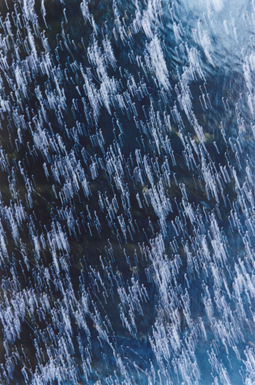 |
|
Here and There introduces art, artists, galleries and museums around Japan that non-Japanese readers and first-time visitors may find of particular interest. The writer claims no art expertise, just a subjective viewpoint acquired over many years' residence in Japan.
|
|
 |
|
|
 |
 |
'Tis the Season: Mika Ninagawa's Sublimely Subdued Sakura Shots
Alan Gleason |
 |
 |
|
 |
|
|
|
 |
|
 |
|
|
|
 |
| Five works from Mika Ninagawa, PLANT A TREE (2011); © mika ninagawa |
Sakura season is over in Tokyo, though as this article goes to press the blossom front continues to move north through Tohoku. In its wake, however, the capital boasts no dearth of cherry-themed art exhibitions these days. One of the most lyrical is PLANT A TREE, a series of color images of cherry trees in full bloom along Tokyo's Meguro River, captured by photographer Mika Ninagawa in the spring of 2010.
More of a canal than a river, the Meguro is a narrow, concrete-encased channel that can be considered charming only during the week or so each April when the somei-yoshino cherries that line its banks for several kilometers all burst into flower at once. Ninagawa spent a single afternoon shooting this spectacle from every conceivable angle: puffy pink-white blossoms set against the sky, the water's surface, or the paved embankment; petals dotting the black river like so many stars; and a remarkable abstraction of parallel strands of white light cascading through indigo water, like a long-exposure shot of a meteor shower in the night. Indeed, aside from a few blossoms that remain sharply in focus, nearly all these images are softly abstract, the sakura-and-water motif serving merely as a trigger for reveries about the cosmos.
Tomio Koyama Gallery wisely chose to install this show in the smaller and more intimate of its two spaces on the top floors of the Maruhachi Warehouse in Koto-ku. Printed on board projecting a few inches from the wall, each of Ninagawa's works is precisely spotlit to achieve an illusion of backlighting that makes the blossoms appear luminescent in the otherwise dark room.
A protean artist who crossed over into celebrityhood some time ago, Ninagawa may be best known for her lavish, color-saturated photos of flowers and fashion models. She has a long resume as a commercial photographer, has published numerous photo books, and has directed two films. Aided and abetted by her association with Tomio Koyama Gallery, Japan's most successful purveyor of contemporary Japanese art to the West (other clients include Takashi Murakami and Yoshitomo Nara), Ninagawa enjoys a larger-than-life presence on the Tokyo art scene today. Hence it is a pleasant surprise to see the gentle poetry she brings to a subdued, small-scale project like PLANT A TREE.
Be that as it may, the opening-day reception was replete with the requisite hoopla. Ninagawa and her editor Satoshi Machiguchi held cheerful court before a galleryful of fans, sponsors, and the press; outside, massive floral arrangements bore congratulatory messages from corporate patrons; even a bevy of sumo wrestlers was on hand. All this, for what turned out to be -- once the crowd dispersed -- a profoundly meditative viewing experience.
 |
| Installation view of PLANT A TREE at Tomio Koyama Gallery, 2012; © mika ninagawa. Photo: Kenji Takahashi |
|
|
|
 |
|
Nana Funo, detail from a song of dark forest (2012), 227.5 x 546.0 cm (3 pieces); © Nana Funo |
|
|
|
Happily, the contemplative mood is maintained in the larger upstairs gallery, where Vessel That Never Leaks, an exhibition of paintings by Nana Funo, is on concurrent display with Ninagawa's show. Funo fills her canvases, some of which are mural-size, with intense, minute patterns of iterated motifs -- animals, birds, trees, mermaids, centaurs -- bound together by a mosaic of tree leaves. Thickly layered and masked, with repeated applications of gesso, acrylic, and pen, the paintings are richly textured and conjure up whole worlds of fairytale fantasy, but their prevailing color is a soft silvery gray. Though the details certainly merit a close-up view, it is the serene aura these works emit at a slight remove that sticks in the memory. Whether intentionally or coincidentally, Funo's color scheme and the gray-pink world of Ninagawa's urban riverbank cherry blossoms go extremely well together, and it is to the credit of the curators that visitors can enjoy both exhibitions in tandem.
|
|
|
|
|
Mika Ninagawa: PLANT A TREE
Nana Funo: Vessel That Never Leaks |
|
Tomio Koyama Gallery |
|
21 April - 2 June 2012 |
|
6th and 7th floors, Maruhachi Warehouse, 1-3-2 Kiyosumi, Koto-ku, Tokyo
Phone: 03-3642-4090
Open Tuesday thru Saturday, 12 noon to 7:00 p.m.; closed Sunday, Monday, and national holidays
Transportation: 7 minutes' walk from Kiyosumi-Shirakawa station on the Tokyo Metro Hanzomon Line and Toei Oedo Line |
 |
|
 |
|
|
 |
 |
Alan Gleason
Alan Gleason is a translator, editor and writer based in Tokyo, where he has lived for 25 years. In addition to writing about the Japanese art scene he has edited and translated works on Japanese theater (from kabuki to the avant-garde) and music (both traditional and contemporary). |
|
|
|
 |
|